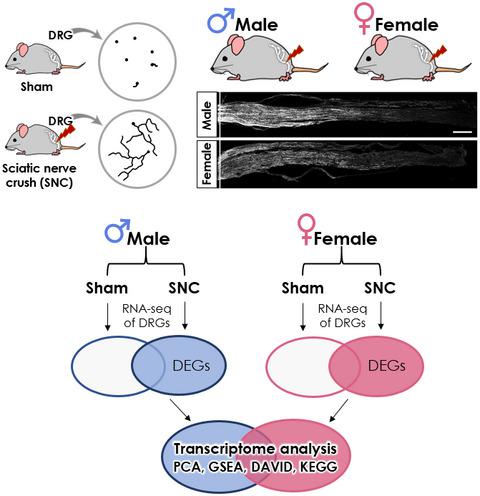当前位置:
X-MOL 学术
›
J. Neurosci. Res.
›
论文详情
Our official English website, www.x-mol.net, welcomes your
feedback! (Note: you will need to create a separate account there.)
Comparing axon regeneration in male and female mice after peripheral nerve injury
Journal of Neuroscience Research ( IF 2.9 ) Pub Date : 2021-09-12 , DOI: 10.1002/jnr.24955 Eun-Hae Jang 1 , Yun-Hee Bae 1 , Eun Mo Yang 1, 2 , Yunho Gim 1 , Hyun-Jun Suh 1 , Subin Kim 1 , Seong-Min Park 3 , Jong Bae Park 3, 4 , Eun-Mi Hur 1, 2, 5
Journal of Neuroscience Research ( IF 2.9 ) Pub Date : 2021-09-12 , DOI: 10.1002/jnr.24955 Eun-Hae Jang 1 , Yun-Hee Bae 1 , Eun Mo Yang 1, 2 , Yunho Gim 1 , Hyun-Jun Suh 1 , Subin Kim 1 , Seong-Min Park 3 , Jong Bae Park 3, 4 , Eun-Mi Hur 1, 2, 5
Affiliation

|
Axons in the adult mammalian central nervous system fail to regenerate after injury. By contrast, spontaneous axon regeneration occurs in the peripheral nervous system (PNS) due to a supportive PNS environment and an increase in the intrinsic growth potential induced by injury via cooperative activation of multifaceted biological pathways. This study compared axon regeneration and injury responses in C57BL/6 male and female mice after sciatic nerve crush (SNC) injury. The extent of axon regeneration in vivo was indistinguishable in male and female mice when observed at 3 days after SNC injury, and primary dorsal root ganglion (DRG) neurons from injured, male and female mice extended axons to a similar length. Moreover, the induction of selected regeneration-associated genes (RAGs), such as Atf3, Sprr1a, Gap43, Sox11, Jun, Gadd45a, and Smad1 were comparable in male and female DRGs when assessed by quantitative real-time reverse transcription polymerase chain reaction. Furthermore, the RNA-seq analysis of male and female DRGs revealed that differentially expressed genes (DEGs) in SNC groups compared to sham-operated groups included many common genes associated with neurite outgrowth. However, we also found that a large number of genes in the DEGs were sex dependent, implicating the involvement of distinct gene regulatory network in the two sexes following peripheral nerve injury. In conclusion, we found that male and female mice mounted a comparable axon regeneration response and many RAGs were commonly induced in response to SNC. However, given that many DEGs were sex-dependently expressed, future studies are needed to investigate whether they contribute to peripheral axon regeneration, and if so, to what extent.
中文翻译:

雄性和雌性小鼠周围神经损伤后轴突再生的比较
成年哺乳动物中枢神经系统中的轴突在受伤后无法再生。相比之下,外周神经系统 (PNS) 中发生自发轴突再生,这是由于支持性 PNS 环境和通过协同激活多方面生物途径导致损伤诱导的内在生长潜力增加。本研究比较了 C57BL/6 雄性和雌性小鼠在坐骨神经挤压 (SNC) 损伤后的轴突再生和损伤反应。在 SNC 损伤后 3 天观察到雄性和雌性小鼠体内轴突再生的程度无法区分,并且来自受伤的雄性和雌性小鼠的原代背根神经节 (DRG) 神经元将轴突延伸到相似的长度。此外,诱导选定的再生相关基因 (RAG),例如Atf3、Sprr1a、Gap43、Sox11、Jun、Gadd45a和Smad1当通过定量实时逆转录聚合酶链反应评估时,男性和女性 DRGs 具有可比性。此外,男性和女性 DRGs 的 RNA-seq 分析显示,与假手术组相比,SNC 组中的差异表达基因 (DEGs) 包括许多与神经突生长相关的常见基因。然而,我们还发现 DEG 中的大量基因具有性别依赖性,这表明在外周神经损伤后两种性别中不同的基因调控网络的参与。总之,我们发现雄性和雌性小鼠产生了相当的轴突再生反应,并且许多 RAG 通常被诱导以响应 SNC。然而,鉴于许多 DEG 具有性别依赖性表达,
更新日期:2021-09-12
中文翻译:

雄性和雌性小鼠周围神经损伤后轴突再生的比较
成年哺乳动物中枢神经系统中的轴突在受伤后无法再生。相比之下,外周神经系统 (PNS) 中发生自发轴突再生,这是由于支持性 PNS 环境和通过协同激活多方面生物途径导致损伤诱导的内在生长潜力增加。本研究比较了 C57BL/6 雄性和雌性小鼠在坐骨神经挤压 (SNC) 损伤后的轴突再生和损伤反应。在 SNC 损伤后 3 天观察到雄性和雌性小鼠体内轴突再生的程度无法区分,并且来自受伤的雄性和雌性小鼠的原代背根神经节 (DRG) 神经元将轴突延伸到相似的长度。此外,诱导选定的再生相关基因 (RAG),例如Atf3、Sprr1a、Gap43、Sox11、Jun、Gadd45a和Smad1当通过定量实时逆转录聚合酶链反应评估时,男性和女性 DRGs 具有可比性。此外,男性和女性 DRGs 的 RNA-seq 分析显示,与假手术组相比,SNC 组中的差异表达基因 (DEGs) 包括许多与神经突生长相关的常见基因。然而,我们还发现 DEG 中的大量基因具有性别依赖性,这表明在外周神经损伤后两种性别中不同的基因调控网络的参与。总之,我们发现雄性和雌性小鼠产生了相当的轴突再生反应,并且许多 RAG 通常被诱导以响应 SNC。然而,鉴于许多 DEG 具有性别依赖性表达,











































 京公网安备 11010802027423号
京公网安备 11010802027423号